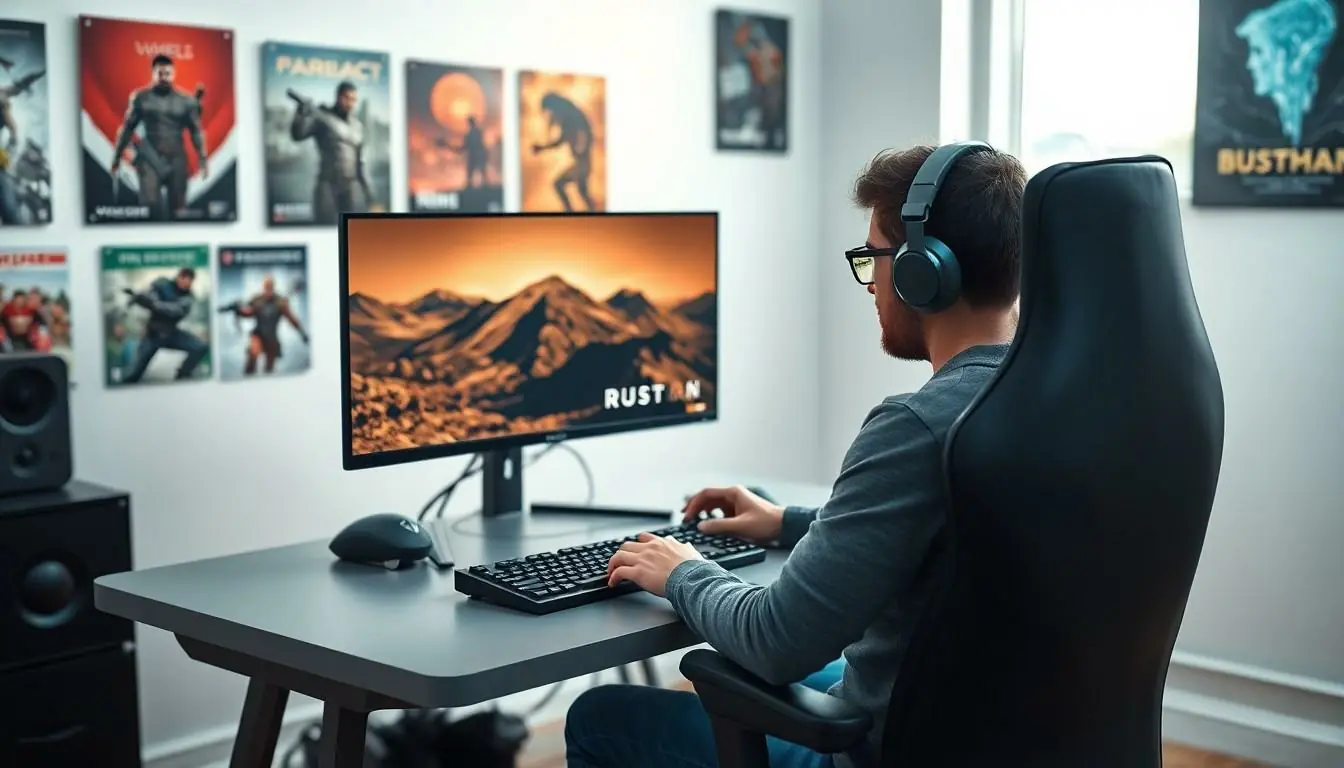In the wild world of Rust, survival isn’t just about dodging bears and crafting makeshift weapons; it’s also about making sure your computer can handle the chaos. Imagine gearing up for an epic raid only to find your rig gasping for breath like it just ran a marathon. Not the best way to kick off a gaming session, right?
Table of Contents
ToggleOverview of Rust Game Requirements
Rust demands specific system requirements to ensure a seamless gaming experience. Players face performance issues if their systems fall short. Minimum specifications include a dual-core processor with at least 2.5 GHz, 8 GB of RAM, and a DirectX 11 compatible graphics card. These requirements cater to basic functionality.
Recommended specifications significantly enhance gameplay. A quad-core processor with 3.0 GHz, 16 GB of RAM, and a graphics card like NVIDIA GeForce GTX 670 or AMD Radeon HD 7870 is ideal. Meeting these improves visual fidelity and performance during intense game moments.
Operating system compatibility remains crucial. Windows 10 (64-bit) is necessary for optimal performance. Updates on the latest version often include stability improvements, enhancing the Rust experience.
Network bandwidth influences online gameplay. A consistent connection with at least 10 Mbps download speed reduces lag and helps maintain smooth gameplay. High latency often disrupts immersion and can result in a frustrating experience.
Players must also account for storage space. Rust requires about 20 GB of free disk space for installation. Regular updates may increase the storage needed, so keeping adequate free space ensures a hassle-free installation process.
Choosing the right hardware components directly impacts gameplay. Investing in a powerful CPU, ample RAM, and a strong graphics card not only boosts performance but also prepares players for future updates and expansions. By understanding these requirements, players can better equip themselves for the challenges that Rust presents.
Minimum System Requirements
Understanding the minimum system requirements for Rust ensures optimal performance and a smoother gaming experience. Below are the key specifications players need to meet.
Operating System
Windows 10 (64-bit) serves as the minimum operating system for Rust. This version supports necessary updates and features for stability during gameplay. Other OS versions may not provide adequate performance or compatibility. Choosing a supported OS is vital for handling the game’s demands effectively.
Processor
A dual-core processor with a speed of at least 2.5 GHz is essential for running Rust. This configuration allows the game to function properly, managing tasks efficiently. Many players benefit from quad-core processors, which provide enhanced performance, though not strictly required for minimum settings. Selecting a compatible processor influences overall gameplay fluidity.
Memory
Players need a minimum of 8 GB of RAM for Rust. Insufficient memory can lead to performance degradation, affecting load times and responsiveness. Upgrading to 16 GB is recommended for a significantly improved experience. Proper memory allocation minimizes lag during intense gaming moments, enhancing player engagement.
Graphics
A DirectX 11 compatible graphics card is mandatory for playing Rust. Suitable options include the NVIDIA GeForce GTX 660 or AMD Radeon HD 7770 as minimum requirements. These cards ensure visual quality and a better frame rate in dynamic environments. Advanced graphics processing enhances player immersion, making hardware selection crucial.
Storage
Rust requires approximately 20 GB of free disk space for installation. This space accommodates necessary game files and future updates, which may demand additional storage. Ensuring ample disk space prevents installation issues and maximizes performance. Regular checks for available storage facilitate a smooth gaming experience.
Recommended System Requirements
For an optimal Rust experience, players should consider the following system requirements. These specifications enhance gameplay, ensuring smooth performance and visual quality.
Operating System
Windows 10 (64-bit) serves as the required operating system for Rust. This version provides better stability and compatibility with modern hardware. Regular system updates can enhance performance and security, so keeping the operating system current proves essential. Alternatives generally do not support the game’s demanding requirements.
Processor
A quad-core processor with a minimum speed of 3.0 GHz is recommended for Rust. Such processors effectively handle game calculations and background processes, improving overall performance. Examples of suitable processors include Intel’s i5 series and AMD’s Ryzen 5 series. These processors typically offer better multitasking capabilities, contributing to a smoother gaming experience.
Memory
At least 16 GB of RAM is suggested to run Rust effectively. This amount allows for efficient data handling and faster loading times during gameplay. More RAM benefits players especially when running additional software in tandem with the game. Upgrading from lower specifications enhances both performance and stability.
Graphics
Players should equip their systems with a graphics card like the NVIDIA GeForce GTX 670 or AMD Radeon HD 7870. Such graphics cards provide adequate performance for high-resolution textures and smooth frame rates. Prioritizing a DirectX 11 compatible graphics card ensures that players take full advantage of the game’s visual enhancements.
Storage
Having approximately 20 GB of free disk space is crucial for Rust installation. Considerably more may be necessary for regular updates and expansions. SSDs are preferable as they boost loading times significantly compared to traditional HDDs. Ensuring ample storage space helps maintain a seamless gaming experience and avoids potential installation issues.
Tips for Optimizing Game Performance
Adjusting in-game settings can greatly enhance performance. Lowering graphics settings such as texture quality and shadow resolution improves frame rate consistency. Reducing the rendering distance also helps minimize lag during intense gameplay.
Updating the graphics card drivers is essential for maintaining optimal performance. Regular updates can introduce fixes that resolve crashes and enhance stability. Checking for driver updates every few months keeps the gaming setup efficient.
Utilizing performance monitoring tools can provide valuable insights. Software like MSI Afterburner enables tracking of frame rates, CPU usage, and GPU temperatures. Players can use this data to identify bottlenecks and adjust settings accordingly.
Ensuring background applications remain closed prevents unnecessary resource drain. Programs running during gameplay may compete for CPU and memory, impacting Rust’s performance. Closing non-essential applications keeps more resources available for the game.
Configuring Windows settings also contributes to better performance. Turning off visual effects and optimizing power settings for maximum performance can yield significant gains. Players benefit from switching to high-performance mode in the power settings.
Adjusting network settings is crucial for online play. Setting a static IP address and configuring port forwarding for Rust can reduce latency issues. Players should also use wired connections whenever possible for more stable internet access.
Installing Rust on an SSD enhances load times dramatically. Solid-state drives have faster read and write speeds compared to traditional hard drives. This upgrade ensures quicker access to game files and smoother transitions during gameplay.
Tracking system performance over time allows for informed upgrades. Monitoring frame rates and load times helps identify when it’s time to upgrade hardware components. Staying proactive with hardware improvements prepares players for future expansions and updates in Rust.
Conclusion
Having the right system specifications is crucial for an enjoyable experience in Rust. Players need to ensure their hardware can meet or exceed the recommended requirements to fully immerse themselves in the game. This not only enhances gameplay but also minimizes frustrating performance issues that can arise during critical moments.
Regular maintenance and optimization can further improve performance. By keeping drivers updated and adjusting in-game settings, players can achieve smoother gameplay. Ultimately, investing in robust hardware and following best practices for performance can make all the difference in surviving the challenges Rust presents.


